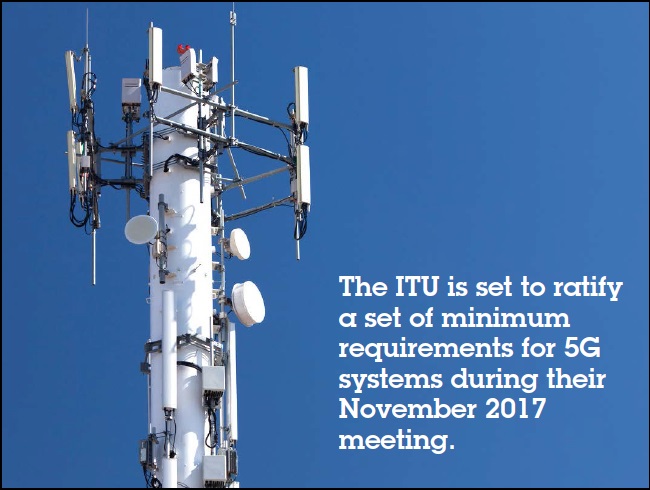The Dazzling Future of 5G Wireless
The verdict is in: 5G wireless systems will be all things to all people, allowing incredibly high bandwidths and ultra-low power radios to be used anywhere, all at a fraction of the cost of today’s devices. Industry journals are filled with reports of successful deployments, and consumers are getting ready for the next generation of smartphones to transport them to a future of connectivity nirvana.
Does this sound too good to be true? Well it is, at least from where the wireless industry stands in 2017. Because the final standards have yet to be ratified, there are lots of interesting trials and experiments underway to move towards a common standard that will be required before handset manufacturers and mobile system operators are able to begin mass deployments. But, as things start to come into focus, it is readily apparent that 5G will transform wireless networking as we know it.

WHAT IS 5G?
Each of the past generations of wireless networking has been named in a series, starting with 1G, which were the first cellphones that used analog channels to provide voice communications. 2G introduced digital radios and text messaging; one popular version was named “GSM.” 3G increased the data channel capacities to at least 200 Kbps, with enhancements that reached into the Megabit range. 4G and 4GLTE are the most advanced standards in use today, and provide all of the features and functions that modern smartphones utilize for delivering streaming video, multimedia messages and millions of voice connections.
The ITU (International Telecommunication Union) is set to ratify a set of minimum requirements (called ITU-R M.IMT-2020 for 5G systems during their November 2017 meeting. These requirements include:
20 Gbps peak downlink rate to a single mobile station, in a perfect environment with all available resources utilized;
10 Gbps peak uplink rate, also under ideal conditions;
100 Mbps user experienced downlink rate, which is the worst data rate that users who are within range of the network should encounter ninety-five percent of the time. This is roughly a hundred times what many current mobile networks are designed to deliver;
50 Mbps user experienced uplink rate, which will be important for wireless cameras and other applications;
4 msec one-way latency across the radio link for enhanced mobile device users, which will help improve throughput for streaming video and file uploads/downloads, and
Up to 1 million simultaneous connections per square kilometer, which means that supporting a dense collection of wireless, low power Internet of Things (IoT) devices will actually be feasible.
One of the ways that 5G will attain all of these impressive performance numbers is by using radios that are capable of delivering 30 bits per second per Hz peak spectral efficiency downlink and 15 bps/Hz uplink, which requires advanced modulation schemes and antennas to be coupled with powerful digital signal processing. Improvements in base station density (number of base stations per unit area) and use of millimeter-wave (30-300 GHz) signals will also be necessary to achieve some of 5G’s performance targets.
IMPACT ON BROADCASTERS
The advances brought by 5G technology are already being experienced by a few lucky users who are involved in early trials of fixed broadband connections based on millimeter-wave radio technologies. These signals, which require high-gain antennas working over direct line-of-sight links, are not able to pass through objects and can experience significant fading due to rain. In spite of these limitations, 5G fixed wireless technology could make it easier (and less expensive) for carriers to provide high-bandwidth connections to broadcasters who have facilities in so-called “digital deserts” and bring more competition into the local loop market as early as 2018 in some cities.
Broadcasters are increasingly using portable cameras with wireless backhaul for news, sports and remote event coverage, and the advances brought by 5G technology should have a major impact on performance. Unfortunately, broadcasters’ ability to use these systems will be delayed until carriers are able to deploy base stations that support these technologies in the areas where broadcasters will want to use them. Mass deployment will have to wait for industry standards to be finalized.
Speaking of standards, work is underway in several different committees to define exactly which technologies will be selected to implement 5G’s lofty performance goals. Of course, these decisions will need to balance the needs of users and carriers, patent holders and manufacturers, and result in a system that can be economically implemented using technologies that are going to be available within the next year or two. To help accelerate the standards process, the 3GPP (Third Generation Partnership Project) agreed earlier this year to release 5G NSA (Non-Stand Alone) specifications in March 2018. NSA incorporates the advanced radio technologies of 5G but utilizes 4G LTE infrastructure, a step that is intended to allow commercial services to launch as early as the end of 2018. Full 5G specifications (called 5G SA or Stand Alone) would follow in late 2018 and include the core network improvements needed to fully support IoT devices, enhanced routing protocols, and other advances.
Once the full set of standards is complete, there is still a lot of work that needs to be completed before 5G becomes a reality. Chip designs will need to be finalized, handset manufacturers will need to produce devices, and service providers will need to deploy base stations, most likely beginning in major city centers. The “2020” included in the title of the ITU’s report named above is not only part of the document number, but also the calendar year when true 5G is likely to become commercially available.
Wes Simpson is the president of Telecom Product Consulting. He can be reached via TV Technology.
Get the TV Tech Newsletter
The professional video industry's #1 source for news, trends and product and tech information. Sign up below.
Wes Simpson is President of Telecom Product Consulting, an independent consulting firm that focuses on video and telecommunications products. He has 30 years experience in the design, development and marketing of products for telecommunication applications. He is a frequent speaker at industry events such as IBC, NAB and VidTrans and is author of the book Video Over IP and a frequent contributor to TV Tech. Wes is a founding member of the Video Services Forum.

